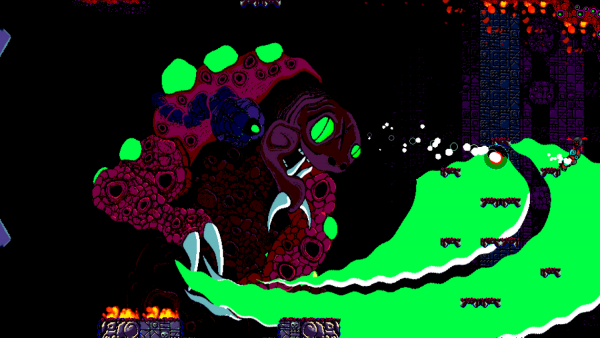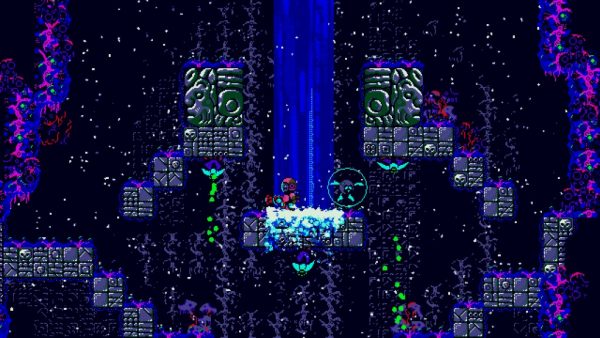
Gaming Writer Kieren Platts reviews Outbuddies, a new metroid-vania game to see how it brings it’s own twist on a classic genre.
Metroid-style exploration was one of my first loves, and the more games in the genre that are released, the more that love grows. In development since 2013, Outbuddies is a game by Julian Laufer, and is not afraid of wearing its heart on its sleeve. The Kickstarter campaign, way back in 2017, sells itself on being “inspired by timeless classics like Super Metroid and Symphony of the Night”. Not a unique foundation, but exciting nonetheless. I couldn’t wait to begin. Upon loading up the game and pressing start, we’re introduced to some static story panels. A nineteenth-century-looking businessman dramatically standing over a map, suiting up, and getting the hell out of here. He lands, he finds an abandoned droid that quickly accompanies his quest. And with that, the game wastes no time in throwing you into actually handling the gameplay itself.
The first thing you’ll notice about playing Outbuddies is that it is insistent on you learning the controls as early as possible, which is no bad thing – there are a lot of them. Apart from being introduced to running, jumping, climbing, dodge-rolling, crawling, sneaking, wall-jumping, swimming, menu navigation, character/audio interaction, and shooting, there is a secondary aide character (the droid) who has telekinesis and enemy-hacking capabilities that can be developed over the course of the game too. And this all takes place within the first few screens of the game, let alone all of the power-ups and abilities you’ll picking up many hours into the game. Admittedly, this is a lot to learn in a short space of time, and you could easily take half an hour or more familiarising yourself with these controls. Cleverly, Outbuddies assumes that those embarking on its journey will already be familiar with the genre, and so sees no reason to strip away moves that Super Metroid players will have been familiar with for years (with the exception of the bomb, perhaps). After getting used to the slightly clunky control scheme, the game does a good job of offering massive versatility, and different approaches to obstacles and enemies all before the game properly begins.
This is perhaps the biggest obstacle to new players, but undoubtedly one of the biggest attractions to veteran players of Metroid-style exploration: the controls demand mastering. Even players used to the genre will find themselves needing to readjust how their fingers move around for side-scrollers, learning how to move around, and executing that movement – occasionally perfectly. Outbuddies is a difficult game, and is proud of it.

In fact, the movement is so complex, and the game is paced in such a way that nearly half of your first play-through will see few if any power ups and extra abilities – the vanilla movement system requires so much finesse and technique that there are enough interesting scenarios to carry the game for hours, slowly upping the challenge. Add all of the hidden caches of missile capacity upgrades and secret treasures, and the game has a similar dynamic difficulty to Super Metroid – do you search every nook and cranny to give yourself a +15% advantage in boss fights? Or do you accept the extra difficulty and get to that boss as fast as possible? It’s your call.
You’ll be running into bosses and mini-bosses alike, and they will hold you up. Having beaten them all, I am still undecided on whether or not a few of them are cheap or not, but one thing is for certain – the fight will sometimes feel out of your control. It is worth going into a boss with a plan, figuring out exactly which of your own movement patterns work, and which ones don’t. There is a large amount of RNG that can be incredibly frustrating at times, but do indeed keep the battles interesting until the very end. To put it simply, these bosses are old-school tough.
Some rooms, some enemies, and some enemy combinations, offer the same stress. Overwhelming to plough through, a relief to escape from. This isn’t necessarily a bad thing, but issues do arise with the game’s stability. I encountered essentially no bugs through my play through (outside of the game forgetting my controller input half of the times I started up the game) until acquiring the charged Corridium Galvanizer. As a weapon? My favourite in the game. As a movement system? Fun as hell to use. As a method of breaking the game and forcing me to restart from my last save? Borderline reliable. As Outbuddies gains popularity, it’s likely we’ll be looking at patches for such issues in the near-future, but as it stands, as of 28th of October 2019, be careful about using this weapon – I ended up in at least fifteen walls over the course of the game that I couldn’t re-emerge from.
“The game continues looking great all the way through
Not that the world is anything to sniff at. The cave system you’re given to explore feels gigantic. Scrolling through the map screen, I couldn’t believe how many rooms there were to uncover. We’re talking easily double Super Metroid, similar in size to Hollow Knight. Six years of development, I would assume, went mainly into creating a map of that size, that movement upgrades are located at the very ends of. Rather than simply unlocking new areas, upgrades in Outbuddies reconceptualises most surfaces in the game. Most rooms are theoretically faster to get through once you pick up the steam boots, the jet pack, and the charged Galvanizer, but only if you dedicate time to learning how to use them. Once you do, you’ll find yourself in volcanic mineshafts, flooded caves, mechanised tribal societies, and wreckages surrounded by acidic pools, represented by art direction that is a spectacle in its own right.
There’s a curious but welcome trend with the Metroid-style genre, and that’s in emulating art limitation-driven art styles. The Aquatic Adventure of the Last Human comes to mind, with its quasi-Commodore 64 style graphics, Hollow Knight taking cues from flash games from the Newgrounds days of self-made internet games, and of course, The Messenger. Outbuddies closes the gap between how Metroid and Super Metroid look, expanding on the former and condensing the latter. In fact, this tiny niche of an NES game that looks too good, or a SNES game that looks over-simplified, gives the atmosphere of bootleg games for 16bit systems. It can feel weird playing at times, even slightly sinister. A feeling that tonally suits the game all the way through. And to address a personal pet peeve of mine, I caught no pixel rotations outside of the vector graphic emulations, which is cause for celebration by itself.

Of course, direction-wise, the art style looks fantastic, and I’m almost positive that the sound font is a modified SNES sound font. Some clips, especially the fake choral sounding ones, sound incredibly familiar – no points for guessing where that idea came from. The game continues looking great all the way though, and some of the high points of the game include finding debris and fossils, somewhere along the spectrum of looking visually appealing, yet not quite being enough detail to completely understand what it is you’re looking at. Many NPCs in the game also fall into this obfuscated look, and it works well.
But, at its heart, the appeal of Outbuddies is the game itself, and as the latest in line to the Metroid-style genre it is impressive to say the least. Its elaboration on movement systems and the nature of upgrades changing your relationship to rooms you’ve explored is still exciting. Outbuddies stays true to form yet innovates beyond what we’ve seen in games that have drawn inspiration from the same lineage, and results in an intensely well-crafted experience. The gameplay shines, and accomplishments are profound. Julian Laufer and his team ought to be proud of themselves. Outbuddies is an essential addition to the genre, improving on areas that other games just never thought of improving, and is valuable experience from start to end. Just be careful with that damned Galvanizer.
Check out more from Kieren below:

Comments